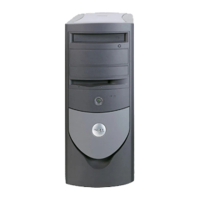2-6
Dell OptiPlex Gn and Gn+ Systems Service Manual
the devices. Because devices may be installed at different times, it is possible
that the same resource is assigned to two or more devices.
Resource conflicts can result in disorderly or erratic computer operation or failure
of the computer to operate at all. If you suspect that resource conflicts might exist,
check the system using the Windows 95 Device Manager or the ISA Configura-
tion Utility (ICU), and reassign the resources as necessary. See “Advanced
Expansion Subsystem” in Chapter 1 for information on the Device Manager and
the ICU. See “Interrupt Assignments” in Chapter 1 to help identify possible con-
flicts. Also review the documentation provided with any installed expansion cards
and other devices for additional interrupt information for the specific devices.
R
unnin
the Dell Dia
nostics
The Dell Diagnostics (included with the computer) contains tests that aid in
troubleshooting all major components of the computer.
To start the diagnostics, turn off the computer, insert a diagnostics diskette into
drive A, and then turn on the computer.
Starting the diagnostics causes the Dell logo to appear on the screen, followed
by a message indicating that the diagnostics is loading. Before the diagnostics
loads, a program tests the portion of random-access memory (RAM) required
for loading the diagnostics. If a main memory error is detected, a message
appears on the screen indicating which DIMM has failed.
If no errors are found in main memory, the diagnostics loads and the Diagnos-
tics Menu appears. This menu lets you choose the following options or exit to
the MS-DOS prompt:
•
Run Quick Tests — Runs selected tests from all test groups to quickly locate
a failure or to indicate where further testing is needed to isolate a failure
•
Run All Tests — Runs all tests for a thorough test of the computer
•
Run Specific Tests — Tests a particular area or subsystem
G
ettin
Help
If none of the troubleshooting procedures in this chapter or the tests in the Dell
Diagnostics reveals the source of the problem or leads to the proper trouble-
shooting steps for determining the source of the problem, call Dell for technical
assistance. For instructions, see “Getting Help” in the online System User’s
Guide.
CAUTION: To prevent damage to the original diagnostics diskette,
always use a backup copy of the diagnostics diskette when servicing a
user’s computer. Dell recommends that users make several copies of this
diskette to ensure that one is always available.

